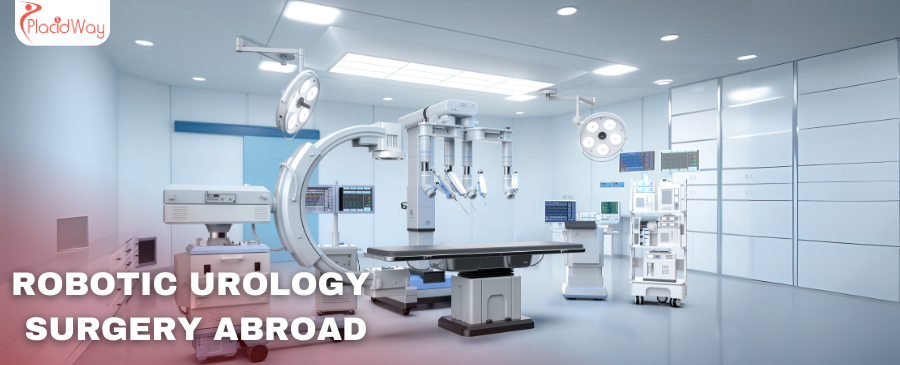
Considering Robotic Urology Surgery? Discover Advanced, Minimally Invasive Options Abroad
Facing a urological condition can be daunting, especially when surgery is recommended. For many, the prospect of complex procedures like prostate removal or kidney surgery brings concerns about recovery, pain, and precision. However, advancements in medical technology, particularly robotic surgery, have revolutionized how these conditions are treated, offering a beacon of hope for a faster, less painful recovery.
Robotic urology surgery utilizes a sophisticated system, such as the da Vinci robot, allowing surgeons to perform intricate procedures through tiny incisions. This translates into unparalleled precision, enhanced visualization, and greater dexterity than human hands alone can achieve. Patients often ask, "Is robotic surgery right for me?" or "What are the benefits of robotic prostatectomy compared to open surgery?" The answer often points to significant advantages: reduced blood loss, less scarring, shorter hospital stays, and a quicker return to daily activities.
This minimally invasive approach is now a standard for treating a range of conditions, from prostate cancer (robotic prostatectomy) and kidney cancer (robotic partial nephrectomy) to complex reconstructive urology. For individuals exploring "affordable robotic surgery" or "best countries for urology treatment," the option of seeking care abroad has become increasingly attractive. Medical tourism offers a path to world-class facilities, highly skilled surgeons, and significant cost savings without compromising on quality or safety. Whether you're researching "symptoms of prostate cancer" or "causes of kidney stones," understanding your treatment options, especially advanced ones like robotic surgery, is the first step towards better health.
What symptoms might indicate a need for robotic urology surgery?
Recognizing the signs that might suggest a serious urological condition is crucial for early diagnosis and effective treatment. While these symptoms can be indicative of many different issues, some common red flags that might lead to a discussion about advanced treatments like robotic surgery include:
- Urinary Changes: Frequent urination, urgent need to urinate, difficulty starting or stopping urination, weak urine stream, or a feeling of incomplete bladder emptying. These are common "prostate problems symptoms" and can indicate conditions like enlarged prostate (BPH) or prostate cancer.
- Blood in Urine (Hematuria): Even a small amount of blood, visible or microscopic, should prompt immediate medical attention. This can be a sign of kidney stones, bladder cancer, or kidney cancer. Patients often search for "why is there blood in my urine."
- Pain: Persistent lower back pain, pelvic pain, or pain in the side (flank pain) that doesn't subside. This can be a symptom of kidney stones, kidney tumors, or other kidney diseases. Acute, severe flank pain often prompts searches for "kidney stone symptoms."
- Sexual Dysfunction: Erectile dysfunction or pain during ejaculation can be associated with prostate issues.
- Unexplained Weight Loss or Fatigue: In advanced stages of cancer, these general symptoms can also appear.
It's important to remember that these symptoms don't always mean cancer, but they warrant a thorough medical evaluation. A doctor will typically perform diagnostic tests such as blood tests (e.g., PSA for prostate), urine tests, imaging (ultrasound, CT, MRI), and sometimes a biopsy to confirm a diagnosis.
What causes urological conditions often treated by robotic surgery?
Urological conditions that benefit from robotic surgery stem from a variety of causes, often involving a combination of genetic, environmental, and lifestyle factors:
- Prostate Cancer: Primarily linked to age, with risk increasing significantly after 50. Family history (genetics) and ethnic background also play a role. Diet (high in red meat, low in vegetables) might contribute, though research is ongoing.
- Kidney Cancer: Risk factors include smoking, obesity, high blood pressure, certain genetic syndromes (e.g., Von Hippel-Lindau disease), and long-term dialysis. Exposure to certain chemicals can also increase risk.
- Bladder Cancer: Smoking is the single largest risk factor. Exposure to industrial chemicals, chronic bladder inflammation, and a family history also increase risk.
- Kidney Stones: Dehydration, diet (high in sodium, animal protein), obesity, certain medical conditions (e.g., hyperparathyroidism, gout), and family history are common causes. Patients often look for "how to prevent kidney stones."
- Ureteropelvic Junction (UPJ) Obstruction: Often congenital (present at birth), caused by abnormal kidney development or crossing blood vessels, leading to a blockage in the flow of urine from the kidney to the ureter.
Understanding these causes helps in prevention and early detection, guiding patients to ask the right questions during medical consultations.
What types of robotic urology procedures are available?
The versatility of robotic platforms allows for a wide array of urological procedures to be performed with enhanced precision. Some of the most common include:
- Robotic-Assisted Radical Prostatectomy: This is the most common robotic urology surgery, used to remove the entire prostate gland when prostate cancer is localized. It aims to achieve cancer control while preserving urinary function and potency. Many patients search for "da Vinci prostatectomy success rates."
- Robotic-Assisted Partial Nephrectomy: For kidney cancer, this procedure removes only the cancerous part of the kidney, preserving the healthy kidney tissue. This is a complex surgery that greatly benefits from robotic precision, minimizing blood loss and ensuring functional outcomes. Patients often look for "minimally invasive kidney surgery."
- Robotic-Assisted Radical Cystectomy: Used for invasive bladder cancer, this involves removing the bladder and creating a new way for urine to exit the body (urinary diversion). Robotic assistance makes this extensive surgery less traumatic.
- Robotic-Assisted Pyeloplasty: This reconstructive surgery corrects a blockage where the kidney meets the ureter (ureteropelvic junction obstruction), restoring normal urine flow and preventing kidney damage.
- Robotic-Assisted Adrenalectomy: Removal of the adrenal gland, often for tumors.
- Robotic-Assisted Sacrocolpopexy: For pelvic organ prolapse in women, though technically not solely urological, it's often performed by urologists.
These procedures showcase how robotic technology extends the benefits of minimally invasive surgery to complex urological conditions.
Who is eligible for robotic urology surgery?
While robotic surgery offers many advantages, it's not suitable for everyone. Eligibility is determined on a case-by-case basis after a thorough evaluation by a urologist or surgical oncologist:
- Condition-Specific Factors: The type, size, location, and stage of the cancer or condition are primary considerations. For instance, robotic partial nephrectomy is ideal for localized kidney tumors, while extensive, aggressive cancers might require open surgery or different treatment approaches.
- Overall Health: Patients must be fit enough to undergo general anesthesia and tolerate surgery. Significant heart or lung conditions, uncontrolled diabetes, or extreme obesity might increase surgical risks, though robotic surgery can often be an option for some patients who might be deemed high-risk for open surgery due to its minimally invasive nature.
- Previous Surgeries: Extensive prior abdominal surgeries can sometimes make robotic access more challenging due to scar tissue, but often, experienced robotic surgeons can still navigate these complexities.
- Patient Preferences: Ultimately, the patient's informed decision, in discussion with their medical team, plays a role.
Your surgeon will discuss all options, including robotic, open, or other non-surgical treatments, to determine the best path forward for your specific situation. Don't hesitate to ask your doctor, "Am I a candidate for robotic surgery?"
What is the typical recovery time and what can I expect after robotic urology surgery?
One of the most appealing aspects of robotic urology surgery is the improved recovery profile compared to traditional open procedures. Here’s what you can generally expect:
- Hospital Stay: Typically shorter, ranging from 1 to 3 days for most procedures. For example, a robotic prostatectomy often involves a 1-2 day stay, whereas open surgery might require 3-5 days.
- Pain Management: Patients usually experience significantly less post-operative pain, requiring fewer opioid pain medications. This is due to smaller incisions and less tissue disruption.
- Incisions: You'll have several small incisions (typically 8-12 mm), which heal quickly and result in minimal scarring. This is a major aesthetic and comfort benefit over the large incision of open surgery.
- Return to Activities:
- Light Activities: Most patients can walk and perform light daily tasks within a few days of discharge.
- Moderate Activities: A return to work (if not physically demanding) and moderate activities typically occurs within 2-4 weeks.
- Strenuous Activities/Heavy Lifting: Usually restricted for 4-6 weeks to allow internal healing.
- Specific Procedure Recovery:
- For robotic prostatectomy, managing urinary incontinence and erectile dysfunction (if they occur) will be part of the recovery process and can take several months to improve.
- For kidney procedures, monitoring kidney function will be important.
Overall, the path to recovery is smoother and faster, allowing patients to regain their independence and quality of life more quickly. Patients often search for "post-op care for robotic prostatectomy" or "how long does it take to recover from robotic kidney surgery."
What are the potential risks and side effects of robotic urology surgery?
Like any surgical procedure, robotic urology surgery is not without potential risks and side effects, though they are generally lower than those associated with open surgery:
- General Surgical Risks:
- Bleeding: Though reduced with robotic precision, some blood loss is possible.
- Infection: At incision sites or internally, though rare.
- Injury to surrounding organs: Though rare, due to enhanced visualization.
- Anesthesia risks: Reactions to medication, breathing problems.
- Blood clots: Deep vein thrombosis (DVT) or pulmonary embolism (PE), preventable with early ambulation and medication.
- Procedure-Specific Risks:
- Robotic Prostatectomy:
- Urinary Incontinence: Often temporary, but can be persistent for some.
- Erectile Dysfunction: Nerve damage affecting sexual function, often improves over time.
- Bladder neck contracture: Narrowing of the bladder opening.
- Robotic Partial Nephrectomy:
- Urinary leak: From the repaired kidney.
- Kidney function impairment: Though often minimal with partial removal.
- Robotic Cystectomy:
- Urinary diversion complications: Issues with the new pathway for urine.
- Bowel obstruction: If parts of the bowel are used for diversion.
- Robotic Prostatectomy:
Your surgeon will thoroughly discuss these risks with you, weighing them against the benefits of the procedure and your individual health profile. "What are the long-term side effects of robotic prostatectomy?" is a common and important question to ask your doctor.
How does the cost of robotic urology surgery compare worldwide?
The financial aspect of advanced medical procedures like robotic urology surgery can be a major barrier for many patients, especially in countries with high healthcare costs. This is where medical tourism offers a compelling alternative. The cost difference can be substantial, often prompting patients to search for "affordable robotic prostatectomy" or "kidney cancer surgery cost abroad."
Here's a general comparison of estimated costs for a common procedure like Robotic Prostatectomy (costs can vary significantly based on hospital, surgeon, complexity, and specific patient needs):
| Country | Estimated Cost (USD) | Notes |
|---|---|---|
| United States | $30,000 - $60,000+ | Highest costs, extensive insurance reliance. |
| United Kingdom | $20,000 - $40,000+ | Private sector costs, NHS waiting lists. |
| Canada | $25,000 - $45,000+ | Often publicly funded, but long wait times for private. |
| India | $8,000 - $15,000 | Highly competitive, JCI accredited hospitals. |
| Turkey | $10,000 - $18,000 | Modern facilities, experienced surgeons, good value. |
| Mexico | $12,000 - $20,000 | Convenient for North American patients, strong medical infrastructure. |
| Thailand | $10,000 - $18,000 | Excellent patient experience, JCI facilities. |
These figures highlight why "cost of robotic surgery overseas" is a popular search query. The savings can be profound, allowing patients to access top-tier technology that might otherwise be unaffordable.
Why consider robotic urology surgery abroad?
For many, the decision to travel for medical care, especially for a complex procedure like robotic urology surgery, is driven by a combination of compelling factors:
- Significant Cost Savings: As seen in the table above, the cost difference can be tens of thousands of dollars, making life-changing surgery accessible. This is often the primary driver for those searching for "affordable medical procedures abroad."
- Access to Advanced Technology: Many international hospitals in medical tourism hubs have invested heavily in the latest robotic surgical systems and state-of-the-art facilities, often comparable to or exceeding those in Western countries.
- Highly Experienced Surgeons: Surgeons in popular medical tourism destinations often perform a high volume of specific procedures, accumulating vast experience with robotic systems. They are frequently U.S. or European board-certified.
- Shorter Wait Times: In countries with universal healthcare systems, long waiting lists for specialist consultations and surgeries are common. Traveling abroad can provide immediate access to necessary treatment.
- Privacy and Discretion: Some patients prefer to undergo significant medical procedures away from their home environment for privacy reasons.
- Combine with Travel: For those who are well enough, the trip can offer a chance to experience a new culture, although the primary focus remains on recovery.
Choosing to undergo "robotic surgery overseas" is a practical decision that blends quality medical care with financial prudence.
Which countries offer the best value for robotic urology surgery?
Several countries have emerged as global leaders in medical tourism for robotic urology surgery, offering a compelling blend of quality and affordability:
- India: Known for its large number of JCI-accredited hospitals, highly skilled surgeons (many trained in the West), and extremely competitive pricing across all medical procedures, including robotic surgery. It's a top choice for "robotic surgery in India."
- Turkey: With its strategic location bridging Europe and Asia, Turkey boasts modern hospitals with state-of-the-art technology and experienced medical professionals. Istanbul, in particular, is a hub for medical tourism, offering excellent value. Many seek "urology treatment in Turkey."
- Mexico: A popular choice for North American patients due to its proximity. Cities like Tijuana, Cancun, and Guadalajara offer JCI-accredited facilities with U.S.-trained surgeons, often at a fraction of the cost found north of the border. "Robotic prostatectomy Mexico" is a common search term.
- Thailand: Renowned for its hospitality and world-class medical facilities, particularly in Bangkok. Thailand provides exceptional patient care, advanced technology, and competitive prices, often combined with a pleasant recovery environment.
- South Korea: A leader in medical innovation and technology, South Korea offers advanced robotic surgery with highly skilled surgeons and excellent outcomes, though costs might be slightly higher than in other Asian destinations, still significantly less than Western countries.
When searching for "best hospitals for robotic urology surgery abroad," these countries frequently top the list due to their established medical tourism infrastructure and quality standards.
How can I ensure safety and quality when traveling abroad for this procedure?
Ensuring safety and quality is paramount when considering medical treatment abroad. It's understandable to have concerns about "safety of robotic surgery abroad." Here are key steps to mitigate risks and make an informed decision:
- Look for International Accreditations: The Joint Commission International (JCI) is the gold standard for healthcare accreditation worldwide. A JCI-accredited hospital signifies that it meets rigorous international patient safety and quality standards.
- Verify Surgeon Credentials and Experience: Research your surgeon's qualifications, board certifications, experience with robotic urology surgery, and the volume of procedures they perform. Many international surgeons have training from top Western institutions.
- Review Patient Testimonials and Outcomes: Look for independent patient reviews and testimonials. Ask the facility for statistics on outcomes for your specific procedure.
- Utilize Reputable Medical Tourism Facilitators: Companies like PlacidWay specialize in connecting patients with vetted, high-quality international providers. They can assist with everything from finding the right doctor and hospital to travel logistics, ensuring a smoother and safer experience.
- Comprehensive Pre-operative Communication: Ensure clear and thorough communication with your medical team abroad before you travel. This includes sharing all your medical records and understanding the entire treatment plan.
- Post-operative Care Plan: Discuss the post-operative care plan and how follow-up will be managed once you return home.
By taking these steps, you can confidently access advanced robotic urology surgery with peace of mind, knowing you’ve prioritized your safety and quality of care.
Take the Next Step with PlacidWay
Ready to explore treatment options abroad? Discover top clinics, compare prices, and get a free quote tailored to your needs with PlacidWay.










Share this listing